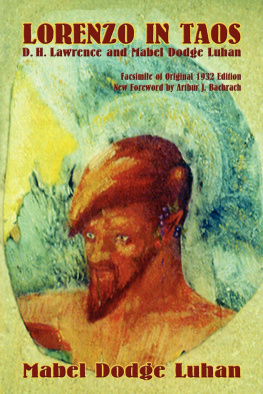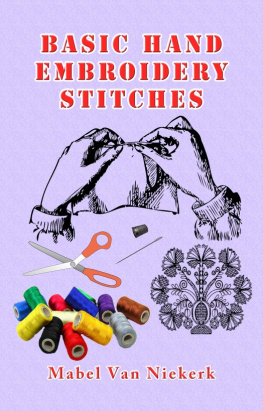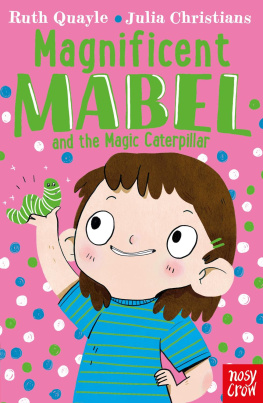

New Material 2007 by Sunstone Press. All Rights Reserved.
No part of this book may be reproduced in any form or by any electronic or mechanical means including information storage and retrieval systems without permission in writing from the publisher, except by a reviewer who may quote brief passages in a review.
Sunstone books may be purchased for educational, business, or sales promotional use. For information please write: Special Markets Department, Sunstone Press, P.O. Box 2321, Santa Fe, New Mexico 87504-2321.
Library of Congress Cataloging-in-Publication Data
Luhan, Mabel Dodge, 1879-1962.
Lorenzo in Taos: D.H. Lawrence and Mabel Dodge Luhan / by Mabel Dodge Luhan; new foreword by Arthur J. Bachrach.
p. cm. -- (Southwest heritage series)
Facsimile of 1932 edition.
ISBN 978-0-86534-594-2 (softcover: alk. paper)
ISBN 978-1-61139-451-1 (e-book)
1. Lawrence, D. H. (David Herbert), 1885-1930--Travel--New Mexico--Taos. 2. Lawrence, D. H. (David Herbert), 1885-1930--Friends and associates. 3. Authors, English--20th century--Biography. 4. Taos (N.M.)--Biography. 5. Luhan, Mabel Dodge, 1879-1962. I. Title.
PR6023.A93Z66 2008
823.912--dc22
[B]
2007027392

WWW.SUNSTONEPRESS.COM
SUNSTONE PRESS / POST OFFICE BOX 2321 / SANTA FE, NM 87504-2321 /USA (505) 988-4418 / ORDERS ONLY (800) 243-5644 / FAX (505) 988-1025
T he Southwest Heritage Series is dedicated to Jody Ellis and Marcia Muth Miller, the founders of Sunstone Press, whose original purpose and vision continues to inspire and motivate our publications.
CONTENTS
I
THE SOUTHWEST HERITAGE SERIES
II
FOREWORD TO THIS EDITION
III
THE WOMAN WHO MARRIED AN INDIAN
from The Stronghold
by
Phillips Kloss
Sunstone Press 1987
IV
PORTRAIT OF MABEL DODGE LUHAN
by
Harold Butcher
from
The Santa Fean
October 1940
V
FACSIMILE OF 1932 EDITION
I
THE SOUTHWEST HERITAGE SERIES
T he history of the United States is written in hundreds of regional histories and literary works. Those letters, essays, memoirs, biographies and even collections of fiction are often first-hand accounts by people who wanted to memorialize an event, a person or simply record for posterity the concerns and issues of the times. Many of these accounts have been lost, destroyed or overlooked. Some are in private or public collections but deemed to be in too fragile condition to permit handling by contemporary readers and researchers.
However, now with the application of twenty-first century technology, nineteenth and twentieth century material can be reprinted and made accessible to the general public. These early writings are the DNA of our history and culture and are essential to understanding the present in terms of the past.
The Southwest Heritage Series is a form of literary preservation. Heritage by definition implies legacy and these early works are our legacy from those who have gone before us. To properly present and preserve that legacy, no changes in style or contents have been made. The material reprinted stands on its own as it first appeared. The point of view is that of the author and the era in which he or she lived. We would not expect photographs of people from the past to be re-imaged with modern clothes, hair styles and backgrounds. We should not, therefore, expect their ideas and personal philosophies to reflect our modern concepts.
Remember, reading their words and sharing their thoughts is a passport back into understanding how the past was shaped and how it influenced todays world.
Our hope is that new access to these older books will provide readers with a challenging and exciting experience.
II
FOREWORD TO THIS EDITION
by
Arthur J. Bachrach, Ph.D.
I n September, 1922, the internationally known British writer D. H. Lawrence arrived, with his wife, Frieda, at the railroad station in Lamy, New Mexico. They had traveled from Australia to San Francisco, then to Lamy, to come to Taos at the invitation of Mabel Dodge Sterne, the patroness of arts and culture in Taos. Mabel Dodge met the Lawrences at Lamy, driven by her chauffeur, and later husband, Taos Pueblo Indian Tony Luhan. Stopping the night in Santa Fe, they arrived in Taos the following morning, September 11, Lawrences thirty-seventh birthday.
It was the beginning of an intense, sometimes strained, relationship. Mabel, daughter of a well-to-do Buffalo, New York family, had a long history of cultivating arts and letters, surrounding herself with famous artists and writers in her salons in Florence, Italy and in New York City. She continued her support of literature and the arts in Taos and it was her hope that Lawrence would write the definitive novel of the Taos Pueblo. Lawrence did not write the novel Mabel had hoped for, but he did write a number of essays and articles on Indian life and culture.
The relationship between the Lawrences, living close to Mabels big house and Mabel became difficult and was further complicated by the arrival, in March, 1924, of Dorothy Brett, a British artist and friend of the Lawrences, who accompanied them on their return from London to Taos. The interaction of the three women, all devoted to Lawrence, was intense and at times stormy.
Mabel offered the Lawrences a ranch of 160 acres in San Cristobal, some seventeen miles north of Taos. Lawrence refused, presumably unwilling to be any more beholden to Mabel, but Frieda accepted the offer and the deed was in her name. The Kiowa Ranch, as Lawrence named it, became a focus of one of the most productive periods of writing in Lawrences life.
Lawrence encouraged Mabel to write about her own exciting life and, while back in Italy in 1925, continued corresponding with Mabel and edited manuscripts she sent to him. Her book, Lorenzo in Taos, is written loosely in the form of letters to and from D. H. Lawrence, Frieda Lawrence and Robinson Jeffers, the celebrated poet who had been a guest of Mabel's in Taos, with references to Dorothy Brett and Spud Johnson among others. The book is a highly personal and most informative account of an intense relationship with a great writer. It is an important work and its reprinting is welcomed by scholars and those of us who have come increasingly to respect Mabel's contributions in the world of arts and letters through her support of many individuals and her own creative spirit.
Aldous Huxley once claimed that D. H. Lawrence was blessed with an extrasensory perception, an awareness of what Wordsworth called unknown modes of being.'' Huxley said, He was always intensely aware of the mystery of the world, and the mystery was always for him a numen, divine. Lawrence could never forget, as most of us almost continuously forget, the dark presence of the otherness that lies beyond the boundaries of man's conscious mind. This special sensibility was accompanied by a prodigious power of rendering the immediately experienced otherness in terms of literary art.''
Mabel Dodge Luhan must have felt the same way about Lawrence when she enticed him to Taos.
III
THE WOMAN WHO MARRIED AN INDIAN
from
The Stronghold
by
Phillips Kloss











